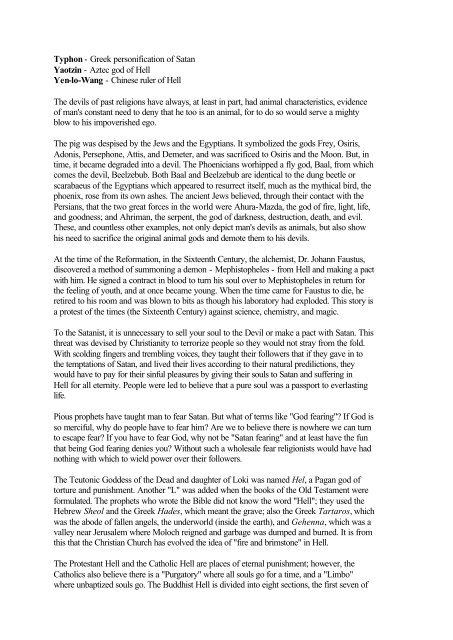o_19160673rcq1190b12mm8mi1nd9a.pdf
You also want an ePaper? Increase the reach of your titles
YUMPU automatically turns print PDFs into web optimized ePapers that Google loves.
Typhon - Greek personification of Satan<br />
Yaotzin - Aztec god of Hell<br />
Yen-lo-Wang - Chinese ruler of Hell<br />
The devils of past religions have always, at least in part, had animal characteristics, evidence<br />
of man's constant need to deny that he too is an animal, for to do so would serve a mighty<br />
blow to his impoverished ego.<br />
The pig was despised by the Jews and the Egyptians. It symbolized the gods Frey, Osiris,<br />
Adonis, Persephone, Attis, and Demeter, and was sacrificed to Osiris and the Moon. But, in<br />
time, it became degraded into a devil. The Phoenicians worhipped a fly god, Baal, from which<br />
comes the devil, Beelzebub. Both Baal and Beelzebub are identical to the dung beetle or<br />
scarabaeus of the Egyptians which appeared to resurrect itself, much as the mythical bird, the<br />
phoenix, rose from its own ashes. The ancient Jews believed, through their contact with the<br />
Persians, that the two great forces in the world were Ahura-Mazda, the god of fire, light, life,<br />
and goodness; and Ahriman, the serpent, the god of darkness, destruction, death, and evil.<br />
These, and countless other examples, not only depict man's devils as animals, but also show<br />
his need to sacrifice the original animal gods and demote them to his devils.<br />
At the time of the Reformation, in the Sixteenth Century, the alchemist, Dr. Johann Faustus,<br />
discovered a method of summoning a demon - Mephistopheles - from Hell and making a pact<br />
with him. He signed a contract in blood to turn his soul over to Mephistopheles in return for<br />
the feeling of youth, and at once became young. When the time came for Faustus to die, he<br />
retired to his room and was blown to bits as though his laboratory had exploded. This story is<br />
a protest of the times (the Sixteenth Century) against science, chemistry, and magic.<br />
To the Satanist, it is unnecessary to sell your soul to the Devil or make a pact with Satan. This<br />
threat was devised by Christianity to terrorize people so they would not stray from the fold.<br />
With scolding fingers and trembling voices, they taught their followers that if they gave in to<br />
the temptations of Satan, and lived their lives according to their natural predilictions, they<br />
would have to pay for their sinful pleasures by giving their souls to Satan and suffering in<br />
Hell for all eternity. People were led to believe that a pure soul was a passport to everlasting<br />
life.<br />
Pious prophets have taught man to fear Satan. But what of terms like "God fearing"? If God is<br />
so merciful, why do people have to fear him? Are we to believe there is nowhere we can turn<br />
to escape fear? If you have to fear God, why not be "Satan fearing" and at least have the fun<br />
that being God fearing denies you? Without such a wholesale fear religionists would have had<br />
nothing with which to wield power over their followers.<br />
The Teutonic Goddess of the Dead and daughter of Loki was named Hel, a Pagan god of<br />
torture and punishment. Another "L" was added when the books of the Old Testament were<br />
formulated. The prophets who wrote the Bible did not know the word "Hell"; they used the<br />
Hebrew Sheol and the Greek Hades, which meant the grave; also the Greek Tartaros, which<br />
was the abode of fallen angels, the underworld (inside the earth), and Gehenna, which was a<br />
valley near Jerusalem where Moloch reigned and garbage was dumped and burned. It is from<br />
this that the Christian Church has evolved the idea of "fire and brimstone" in Hell.<br />
The Protestant Hell and the Catholic Hell are places of eternal punishment; however, the<br />
Catholics also believe there is a "Purgatory" where all souls go for a time, and a "Limbo"<br />
where unbaptized souls go. The Buddhist Hell is divided into eight sections, the first seven of




